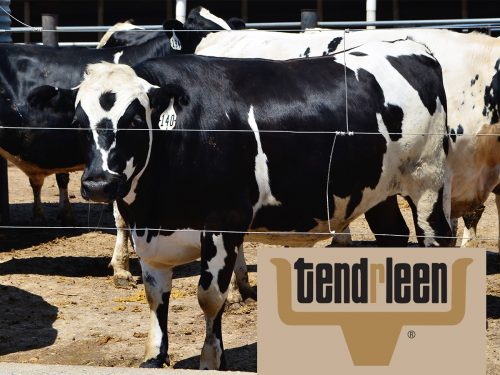Get to Know the Tend-R-Leen® Dairy-Beef Program
Posted: November 7, 2017 | Written By: Lisa Wuertz

When the Tend-R-Leen Dairy-Beef Program was introduced in 1963, it was the first no-roughage dairy-beef program on the market. At that time, the competition said it would never work. Today, Tend-R-Leen is still the leading, most profitable low-roughage, high energy program on the market.
The idea of raising steers on a no-roughage ration was a result of research conducted on milk replacers in the 1950’s, which were introduced at the same time as Tend-R-Leen. After the milk replacer research was complete, the research farm had ample supplies of bull calves to continue additional feeding trials. These trials tested a number of different protein concentrates. The goal was to produce beef at the lowest possible cost.
At that time, everyone considered roughage to be the cheapest source of nutrients. When the research began, it was first conducted with roughage. Results quickly proved that the more grain that was fed, the faster the cattle gained. After several trials of feeding high levels of grain, the first animals were fed a no-roughage ration in 1959. The initial test group included an equal number of Hereford steers and Holstein steers, with an average weight of 130 pounds. The ration consisted of cracked corn and protein supplement. During this trial, no nutritional problems occurred. At 600 pounds, the Herefords were extremely fat, but the Holsteins were well proportioned (muscled) and making very impressive gains. After 11 months on feed, the Holsteins weighed approximately 1000 pounds. The meat from the Holsteins was sampled and proved to be excellent in flavor and quality.
Even after the ration proved to be successful, feeding hay free choice was extensively tested. The results were always the same. The calves that were fed hay ate nearly as much cracked corn and pellets as those that did not. The average daily gain was about the same for both groups but corn/protein required per pound of gain was higher for those receiving hay. When these steers went to slaughter, those receiving hay did not grade as high as those fed straight corn and protein.
This research was later repeated with whole shelled corn finding the same results.
In 1963, the Tend-R-Leen program was made available to dairy-beef producers nationwide as the very first low-roughage, high energy feeding program. In 1964, Doboy decided to experiment with feeding whole shelled corn. The results were much better than expected. Liver abscesses decreased with feeding of whole shelled corn, probably due to the scratch factor. The switch in recommendations was widely accepted by producers and improved the performance of the animals. Since that time, new additives have enhanced the performance of the Tend-R-Leen program, which continues to lead the industry in performance and gains in dairy-beef steers on a high energy program.
The Tend-R-Leen Program feeds Holstein steer calves on a diet consisting of whole shelled corn and the Tend-R-Leen pelleted concentrate from birth to market.
- Over 50 years of proven success from coast to coast.
- Over 10 million steers fed on the Tend-R-Leen program.
- Lowest cost per pound of gain from the farm to the feedlot.
- The simplest program requiring no grinding or processing of corn.
- Less equipment and labor required.
- Easily adapt an existing facility to fit program.
- Up to 50% less manure.
- Average daily gains up to 3.2 pounds or better.
- Improved feed to gain ratio from birth to market.
- Cattle yield high quality, lean, tender meat that meets consumer and packers demands.
- No competitive whole corn & pellet program has ever been able to document research and results that beat the Tend-R-Leen program.
Today, Tend-R-Leen is marketed across the nation in 10 states through our trained Tend-R-Leen Certified Marketing Partners, with opportunities being developed in several other states. To locate a Certified Marketing Partner near you, please contact your local Form-A-Feed representative.